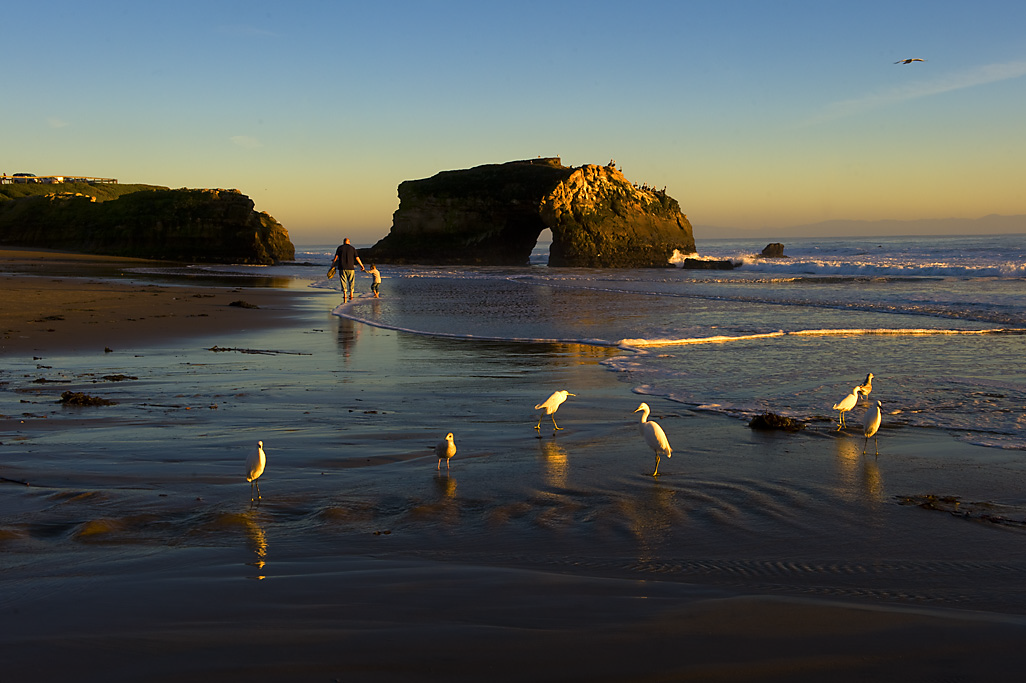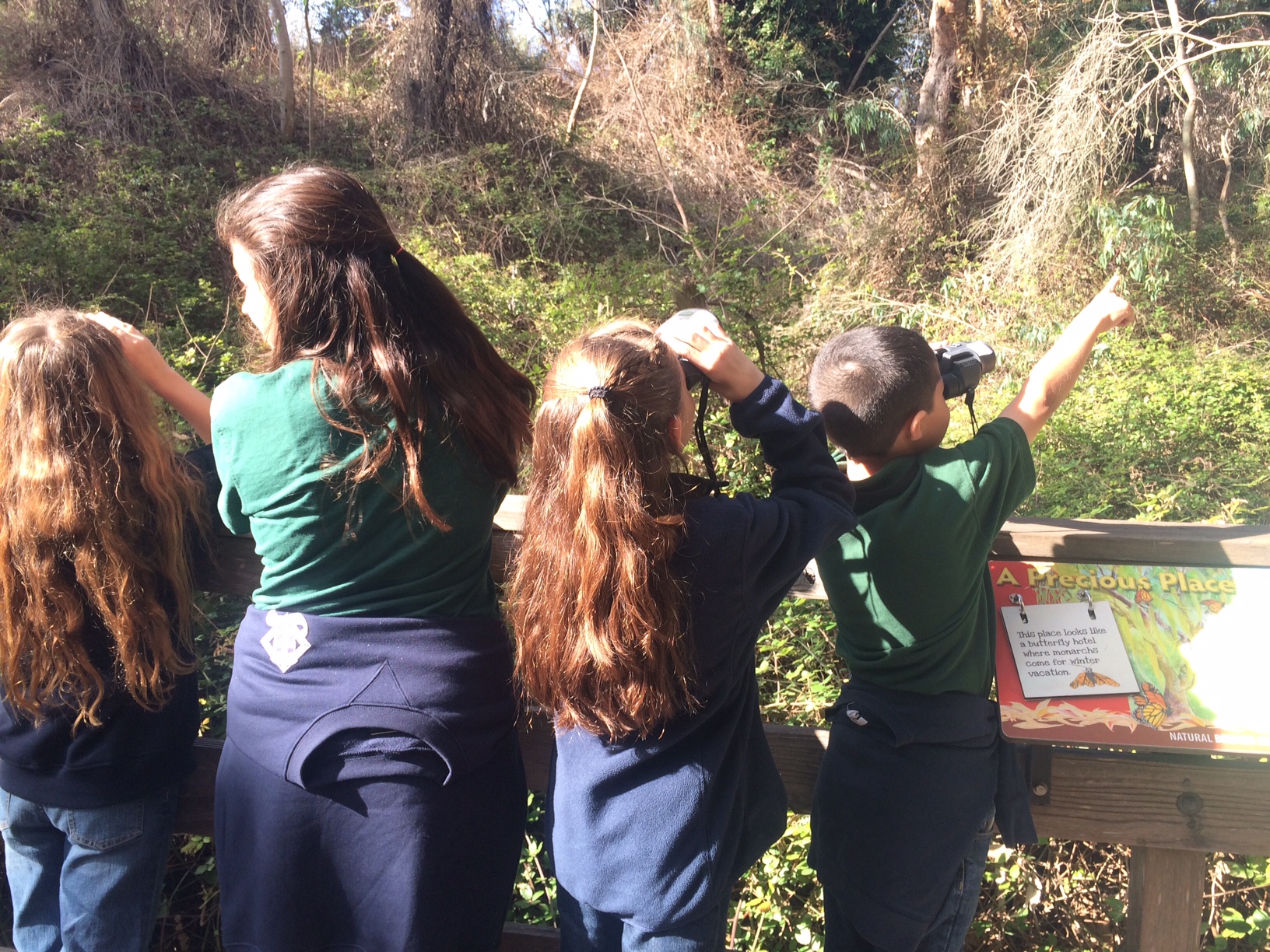Natural Bridges State Beach
The Park is currently OPEN.
Please check the hours of operation.View our guided hikes and other public programs schedule and make a reservation by visiting our Parks Events page!
Visiting Natural Bridges
 This park and beach is an excellent vantage point for viewing shore birds, migrating whales, as well as seals and otters playing offshore. Further along the beach, public access tidepools offer a glimpse of life beneath the sea in this Marine Protected Area. Low tides reveal sea stars, shore crabs, sea anemones, and other colorful ocean life. The park also includes a large area of coastal scrub and grasslands, with bright native wildflowers in the spring. Moore Creek flows through the park, forming freshwater wetlands and a salt marsh before it reaches the sea.
This park and beach is an excellent vantage point for viewing shore birds, migrating whales, as well as seals and otters playing offshore. Further along the beach, public access tidepools offer a glimpse of life beneath the sea in this Marine Protected Area. Low tides reveal sea stars, shore crabs, sea anemones, and other colorful ocean life. The park also includes a large area of coastal scrub and grasslands, with bright native wildflowers in the spring. Moore Creek flows through the park, forming freshwater wetlands and a salt marsh before it reaches the sea.
Monarch Butterfly Natural Preserve: A Welcoming Winter Home
 The park's Monarch Grove provides a temporary home for thousands of Monarchs. In 2024, 10,000 Monarch Butterflies overwintered at Natural Bridges. From late fall into winter, the Monarchs form a "city in the trees." The area's mild seaside climate and eucalyptus grove provide a safe place for monarchs to roost until spring.
The park's Monarch Grove provides a temporary home for thousands of Monarchs. In 2024, 10,000 Monarch Butterflies overwintered at Natural Bridges. From late fall into winter, the Monarchs form a "city in the trees." The area's mild seaside climate and eucalyptus grove provide a safe place for monarchs to roost until spring.
In the spring and summer, the butterflies live in the valley regions west of the Rocky Mountains where the monarch's companion plant, milkweed, is found. For most of the year, where there are monarchs, there are also milkweed plants. Monarchs drink nectar from milkweed flowers, and female monarchs lay their eggs on milkweed leaves. Milkweed contains a toxin that, when ingested by the caterpillar, makes it toxic to other animals. These toxins remain in the butterfly as well, providing protection from predators that would otherwise eat the monarchs.

Monarch migration is variable and population numbers and dates are different each year. The monarchs typically begin arriving in mid-October and leave by mid-February. At Natural Bridges, late October and all of November is often the best time to go for a walk and observe the monarchs. The Monarch Grove at Natural Bridges has been declared a Natural Preserve, thus protecting these butterflies and their winter habitat from human encroachment or harm. It is the only State Monarch Preserve in California.
The grove contains eucalyptus trees which are located in a gently sloping canyon, providing the Monarch needed shelter from the wind. These winter-flowering trees are also a convenient food source for the butterfly. On chilly days when the temperature drops below 60 degrees, the butterflies cluster together in the eucalyptus trees for protection from the elements.
Visitors can view the over-wintering Monarchs by walking down the park's wheelchair and stroller-accessible boardwalk to an observation deck in the eucalyptus grove.
- Please help protect the health of the butterflies: do not touch or otherwise harm the fragile butterflies.
- For everyone's enjoyment, no smoking, dogs, bicycles, skates, or skateboards on the boardwalk.
- Quiet please. Help maintain the sanctuary experience. Monarchs and other visitors are relaxing.
Intertidal Wonders at Natural Bridges State Marine Reserve
The tide pools at Natural Bridges State Beach are filled to the brim with thousands of creatures, each one doing its best to survive in a constantly changing environment. The moon's gravity pulls on the tides twice daily, converting this habitat from a fully submerged underwater world to an arid and exposed rocky shore. Salinity levels skyrocket and hungry predators swoop in for a tasty meal. These tide pools are preserved and protected by law as part of a Marine Protected Area, which will help maintain their pristine state for generations to come. Stop by at low tide to view this awesome display of nature's resiliency.
Visiting the Tide Pools
The Visitor Center has a map to the tide pools. Stop by during open hours to ask for directions. The best time to visit the tide pools is during a low tide which varies every day. You can view low tide times here. Tidepools are best seen at Natural Bridges when the tide is 2 feet or lower. Public tours are offered on Saturdays and Sundays if tide is low enough. Rain and inclement weather cancels.
Remember to practice good tide pool safety:
- Always keep your eye on the ocean: Rogue waves can come out of nowhere and catch unwary bystanders by surprise.
- Watch your step: Tide pools can be wet, slippery, and rocky. Avoid stepping in areas with dark algae.
- Explore with eyes only: The tide pools are a Marine Protected Area, which means no touch and no take. Please respect all wildlife.
Basic Park Information
FEES - There is a $10 vehicle day-use fee. [Regular Sized Auto: $10 (Senior $9, age 62 or older); Bus Parking (10-24 passengers): $50; Bus Parking (25+ passengers): $100]
PICNIC AREA is located off the main parking lot in a eucalyptus and pine trees grove. Tables, barbecues, water faucets and restroom facilities are available. This is a day-use park only, there is no camping.
OCEAN SAFETY— No lifeguards on duty. Enter tide pools only during periods of low tide. Surf can be unpredictable. Hazardous rip currents and large waves can appear out of nowhere and sweep people out to sea. Do not run on the wet rocks of the intertidal area, and never turn your back to the waves. Check at the entrance station or visitor center before entering the ocean and the tide pool areas.
COLLECTING is not allowed—Do not disturb tide pool residents or the butterfly clusters in any way. The park’s plants, animals, and all natural and cultural features are protected by law.
DOGS are allowed only in the parking lots and picnic areas, but NOT on the beach and trails (except for ADA service animals). All dogs must be on a six-foot maximum leash and under human control at all times. Please do not leave your dog unattended in a vehicle. For a list of locations you can take your dog in Santa Cruz County, please click here.
BICYCLES are permitted only on paved roads.
FIRES are not allowed on the beach.
GLASS containers are not allowed on the beach.
ALCOHOL is only allowed in the park with a previously issued special-event permit. Submit permit applications at least 30 days before the event date.
DRONES are not allowed in the park. To protect wildlife and cultural resources, and for the safety and welfare of visitors and staff, the park is closed to the use of Model Aircraft, Unmanned Aircraft Systems (UAS), and Gliders in flight.
WEDDINGS, PARTIES, AND SPECIAL EVENT PERMITS—Please call (831) 400-8519 or email SCD.specialevents@parks.ca.gov
Volunteering

Fall volunteer training starts September 10 with a focus on monarch butterflies, habitats and wildlife in the park.
For more information and the volunteer application, please click here.
School Group Tours
 Natural Bridges State Beach offers several guided tours for school groups including Monarch Tours (offred October through January), Tide Pool Tours (offered March through July), and Guided Nature Walks (all year). For more information, please click here.
Natural Bridges State Beach offers several guided tours for school groups including Monarch Tours (offred October through January), Tide Pool Tours (offered March through July), and Guided Nature Walks (all year). For more information, please click here.







